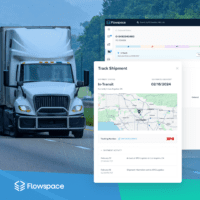
The consumer mentality has transformed, causing brands to revamp their selling strategies. Shoppers are now acclimated to receiving their purchased goods free, fast, and with customization in mind. They want door-to-door delivery but with the option of curbside pickup or in-store browsing, based on their preference on any given day. Flexibility is also a necessary part of the equation.
As a result of these shifts, the path to purchase is no longer linear. Brands must make themselves available to consumers at numerous touchpoints, provide a convenient checkout process, and guarantee an exceptional experience at each juncture. The ability of companies to accommodate these demands will determine their long-term success.
The E-Commerce Revolution in CPG Supply Chains
Understanding the E-Commerce Explosion
The landscape of consumer packaged goods (CPG) has been transformed by the meteoric rise of e-commerce. During the pandemic, online sales have not just grown; they’ve skyrocketed, surpassing physical sales in key sectors for the first time. This shift has brought about a new era of supply chain management, where agility and foresight are paramount.
The ‘Big Squeeze’ on Supply Chains
As e-commerce flourishes, CPG supply chains face a ‘big squeeze’. Demand volatility is at an all-time high, omnichannel retail has become the norm, and the race to meet shrinking lead times is on. The complexity of managing these multifaceted channels is squeezing supply chains from every direction.
Importance of CPG Supply Chain Optimization
A consumer packaged goods (CPG) supply chain is complex and ever-changing. In order to meet demand while also streamlining operations, there are several optimization strategies that CPG companies need to keep in mind. It requires ongoing attention to address and adapt to key business areas, while taking into account ongoing CPG trends, some of which include:
Preventing sales and marketing silos
Data between sales and marketing have largely been siloed in traditional CPG supply chains due to a lack of visibility and real-time insights. Inventory availability and delivery setbacks can impact a brand’s merchandising and marketing strategy, and misalignment negatively affects everything from media spend to consumer experience. Silos are costly, ultimately making it more difficult to gain consumer trust because of lack of information.
Optimizing the consumer experience
Real-time data is only valuable if you use it! Lean on insights to proactively anticipate demand and meet consumer expectations. Ensuring a quality experience means optimizing every part of the supply chain operation for the customer’s benefit, which includes everything from order orchestration to package customization to carrier speed and quality.
Exhibiting agility
Consumer goods supply chain management must be agile and versatile enough that a brand remains competitive. This means being able to adapt quickly to supply chain disruptions, increasing competition, and a changing market. It also requires being open to innovation through technology and automation and prioritizing tasks accordingly.
Implementing sustainability
Consumers across all generations are concerned about what goes into supply chain and fulfillment logistics for CPG, and it’s playing a role in their buying decisions. Reports show even Gen X consumers are influenced by Gen Z values, and nearly 90% are willing to pay more for sustainable products, an increase from 58% across all generations only two years ago.
With Gen Z anticipated to represent 27% of the world’s income by 2030, companies need to review their sustainability practices and find ways to improve their carbon footprint. Supply chains account for more than 80% of greenhouse gas emissions and are an excellent place to start for brands looking to create a foundation of sustainable practices.
Aligning commercial goals with supply chain capabilities
The integration of commercial strategies with supply chain capabilities is no longer optional. It’s a strategic imperative. Regularly revisiting assumptions and market feedback is crucial to stay aligned with the dynamic e-commerce landscape.
Mastering the digital shelf
Dominating the digital shelf means ensuring your products are visible where your customers are shopping. It’s about making strategic choices on where to compete and how to prioritize channels without compromising on market share or profitability.
How to Optimize Your CPG Supply Chain
With these trends in mind, here are five steps you can take to optimize your CPG supply chain:
1. Implement Omnichannel Integrations
Building a relationship with consumers means meeting them wherever they are and providing a seamless, simple path to purchase. Ensuring that all sales channels and order sources are connected with omnichannel insights and fulfillment makes it easy for shoppers to buy, and encourages repeat purchases and recommendations.
Omnichannel integration also leads to improved customer retention strategies. Building authentic connections through transparent communication is part of what separates a strong CPG brand from one quickly forgotten. Customer retention means providing the optimal experience. In the age of ecommerce, this means sharing order updates proactively and personalizing the digital shopping experience based on the customer’s interests and expectations.
That’s why it’s important to access real-time inventory updates, order statuses, and consumer insights on a daily basis. Based on data, CPGs can see where, when, and how their customers most like to shop,and ensure their supply chains are equipped to meet demand.
Omnichannel also connects back to a brands’ relationship with its own partners and suppliers. Establishing open communication and a set order protocol can help the supply chain process run more smoothly and help brands to adjust forecasts and orders as necessary to increase sales.
2. Anticipate Changes in Demand
Maintaining control over product costs, availability, and pricing are levers that put CPG brands in a position to optimize their supply chains while meeting consumer demand. This is achieved by analyzing inventory and logistics metrics to create plans that will sustain and scale company growth. These metrics include inventory turnover, supply chain cycle, fill rates, and other key performance indicators that guide a steady and accurate operational flow.
Equally important is the ability to execute the plan with daily implementation through efficient CPG fulfillment, cost-effective transportation and delivery, and optimized warehousing, especially when holiday ecommerce is a factor. Managing and activating these insights becomes considerably easier by implementing supply chain software from Flowspace. The ability to view insights and orders from every source, centralized in one place, is essential to anticipating demand and making informed allocation decisions.
Flowspace provides delivery statuses, inventory levels, purchase order reports, and other necessary data to make actionable decisions. It also allows business leaders to evaluate areas for improvement and forecast trends rather than waiting until problems pop up and a process starts to unravel.
3. Evaluate New Operating Models
Many brands have shaken up their selling strategies as a result of the pandemic, experiencing exponential growth as a result. Rather than limiting themselves to one operating model, brands have built out a hybrid system that creates more opportunities for sales growth.
For example, integrating new fulfillment orchestration tactics and last-mile delivery solutions offered CPGs an opportunity to experiment with direct-to-consumer (DTC) models in addition to a standard B2B or wholesale approach. Traditional retail operating models are struggling due to inflexibilities within the process that hamper innovation. New integrations and partners help brands to meet the expectations of consumers in today’s market, as opposed to limiting the number of consumers brands can connect with.
Operating models have to shift to a consumer-centric approach, designed with efficiency in mind. Optimizing both online and offline channels helps to improve inventory management, marketing budget, and uncover opportunities for expansion. With Flowspace, brands also have the option to personalize the unboxing experience of customers and create unique branding, in addition to the standard logistics needs of picking, packing, and shipping, which can help brands during peak shipping season especially.
Consumers are bombarded with options of where to buy their goods. Without speaking directly to their needs and choosing to stick to the status quo, it leaves plenty of missed opportunities for brands and a greater likelihood they’ll be left behind.
4. Centralize Strategy
Centralizing supply chain metrics and operations is a way to reduce risk and stay on top of consumer demand. The supply chain slowdown caused by the pandemic illustrated how unpredictability can immediately deflate a company’s best efforts. Even as production levels return to a more normalized state, there will always be market fluctuations to deal with.
A crucial part of a focused, centralized strategy is to integrate all storefronts into one place where real-time data and insights are readily available. Having accurate, up-to-date information allows businesses to create inventory planning solutions that can adapt to a changing market. It can prevent stockouts, extraneous storage fees, and ensure there’s enough supply to meet the current demand.
Those who handle CPG supply chain management via a manual process versus software and automation technology increase the risk of human error, as well as inefficiencies across the board. Without real-time insights into inventory tracking, as well as market demand, brands will always feel a step behind where they need to be. Additionally, there’s a greater probability of scheduling delays and delivery inaccuracies, putting them even further behind the competition.
5. Implement New Technologies
To streamline consumer goods supply chain capabilities, introducing artificial intelligence and data tracking is a way to keep tabs on the location and status of all inventory from start to finish. Additionally, fulfillment technology can streamline the logistics process to free up time to focus on other areas of business growth like strategic planning and demand forecasting.
Both strategic and tactical planning are necessary to optimize supply chains and stay flexible. Strategic planning requires establishing a framework to determine optimal warehousing and storage locations, inventory allocation, and how to monitor changes in consumer demand. Once tactical planning is in place, there are daily adjustments that need to take place in order to stay aligned with current market trends.
This involves planning for every step of the supply chain, including assessing best practices in inventory, pricing, storage, and selling. For example, increasing safety stock to avoid product shortages during times of high demand is part of a tactical plan that can fall under the umbrella of a larger strategic framework. By streamlining the logistics process, brands further enable scalability.
Advanced Distribution Network Models
Adopting advanced distribution network models is key to managing the complexities of e-commerce. Multi-echelon models and predictive ordering systems are not just buzzwords; they are essential tools for efficient supply chain management.
Data-Driven Decision Making
In the age of big data, predictive analytics and robust inventory-planning systems, like real-time inventory management software, are the backbones of a responsive supply chain. Leveraging these tools can lead to more informed decisions and a significant competitive advantage.
Optimize Your CPG Supply Chain with Flowspace
Flowspace software allows brands to maintain control over their entire fulfillment network to meet customer demands. The Flowspace network includes FDA-certified locations and capabilities to handle items that require lot-tracking and reporting, as well as locations capable of handling oversize items regardless of size, shape, or weight. The platform empowers brands to take control of fulfillment operations and optimize success with integrated order management, inventory planning, network optimization, and customer insight capabilities.
Optimizing the CPG supply chain starts with deploying fast, omnichannel fulfillment. The Flowspace platform provides the visibility, integration, and efficiency necessary to maintain accurate inventory and deliver a quality consumer experience. And when there is a reliable foundation in place, it opens up greater growth opportunities.
Sources:
- Forbes. Consumers Demand Sustainable Products and Shopping Formats. https://www.forbes.com/sites/gregpetro/2022/03/11/consumers-demand-sustainable-products-and-shopping-formats/
- Netsuite. Supply Chain Planning: Strategy, Process, and Practices. https://www.netsuite.com/portal/resource/articles/erp/supply-chain-planning-scp.shtml
- Accenture. Winning in the New Age of Digital Consumer. https://www.accenture.com/_acnmedia/PDF-157/Accenture-Winning-in-Age-of-Digital-Consumer.pdf
- Forbes. When It Comes To CPG and Food and Beverage Companies – Investing in Purpose-Built Supply Chain Intelligence Matters. https://www.forbes.com/sites/paulnoble/2022/06/23/when-it-comes-to-cpg-and-food–beverage-companiesinvesting-in-purpose-built-supply-chain-intelligence-matters/
- IBM – What is supply chain optimization? https://www.ibm.com/topics/supply-chain-optimization/





